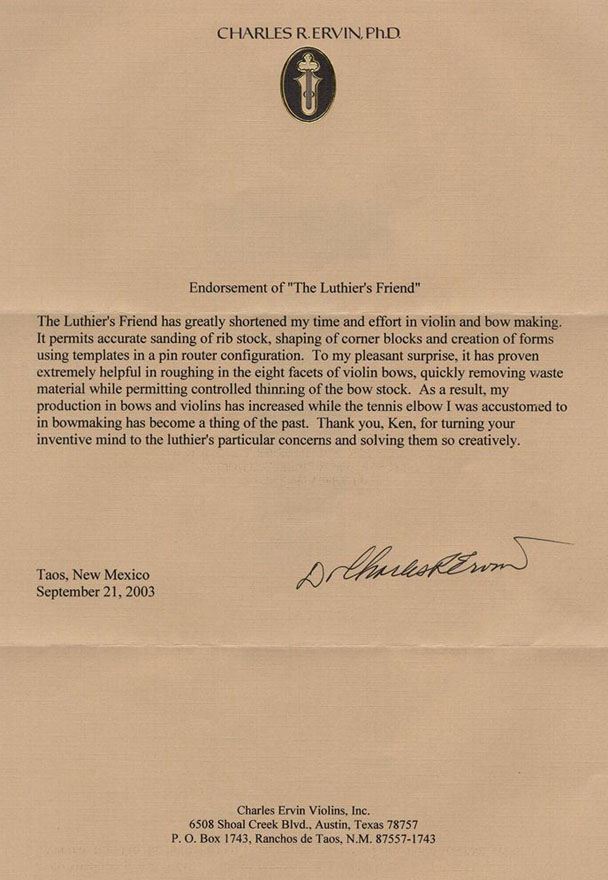Reviews & Letters
Back to Luthiers Friend
| Woodworker's Journal e-Zine (Jan. 07) | StewMac Trade Secrets (April 07) |
| Fine WoodWorking (Oct. 05) | American Lutherie ( Winter 05) |
| Woodshop News (Jan. 05) | Popular Woodworking (Feb. 06) |
Maker Faire 2007 Editor's Choice Award
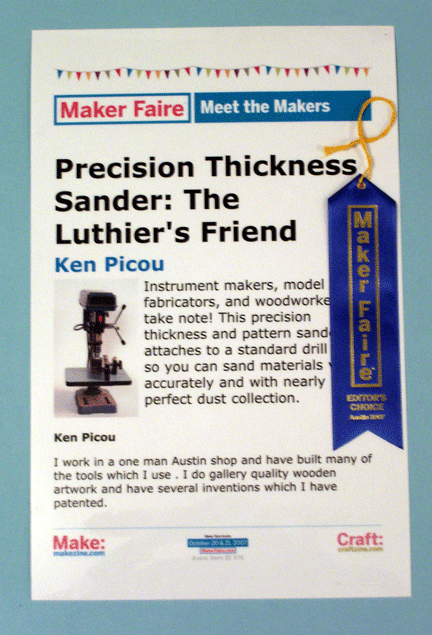
The Maker Faire is put on by Make and Craft Magazines (O'Reilly Press). It's a huge festival geared toward encouraging inventiveness and the "do it yourself" mindset. It is very inclusive and covers the spectrum from robotics to lacemaking. Very "hands on" and great fun.
Sort of like Mr. Wizard meets Burning Man .
Fine WoodWorking Magazine, October '05
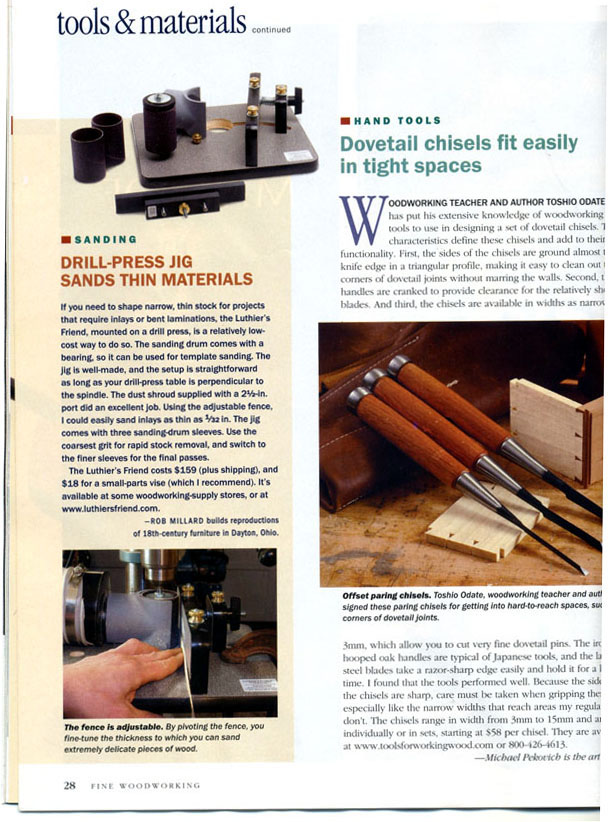 Back
Back
Woodshop News, January '05
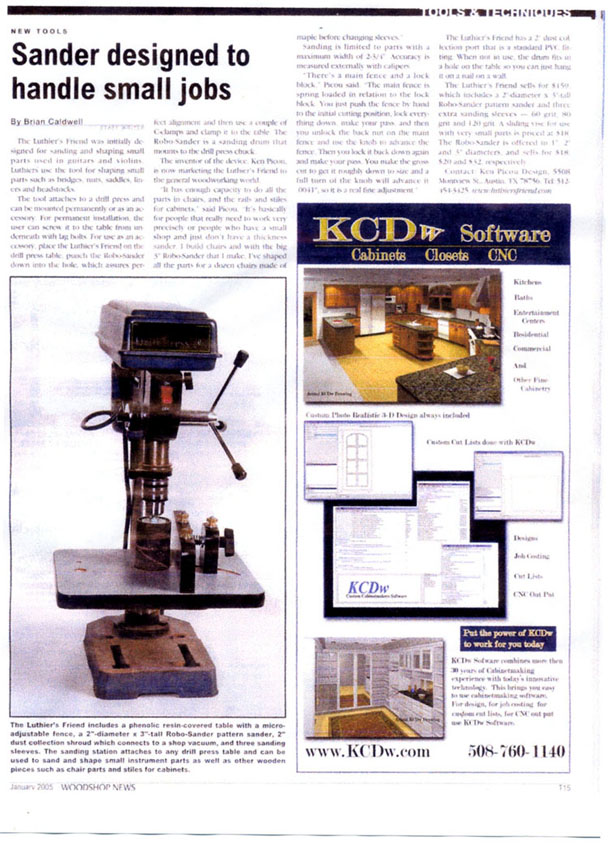 Back
Back
Popular Woodwork February '06
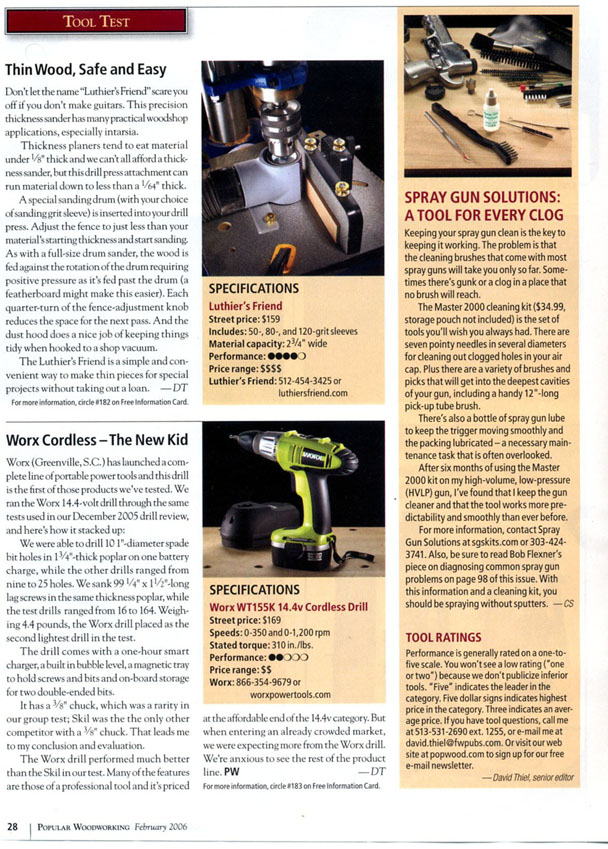 |
Stewart MacDonald Trade Secrets
Dan Erlewine April 5, 2007
I’m making better acoustic bridges than ever before
I liked the Luthier’s Friend Sanding Station the first time I saw it, and I use it a lot for thickness sanding. But messing around last Saturday,
I got into a whole new ballgame with it.
I couldn’t stop using it! I was having fun, and I spent last Saturday making this radius jig for bridges.
(You can read the rest of Dan's very cool and informative article in full on the Stewart MacDonald website in their Trade Secrets Archive .)
---------------------------------------------------------------------------------------
American Lutherie #84 Winter 2005
Product Reviews
by Keith Davis
(page is printed text only at the request of publisher)
Everybody needs a friend. As working luthiers, we know that it would be nice to have a friend who could pitch in, give us a hand,perhaps get us out of the shop a bit earlier some days (and not contact our clients from their homes after-hours). Well, that friend has arrived in the form of, yes, you guessed it, The Luthier's Friend made by Ken Picou at his production shop in Texas. This thickness-sanding
station, designed to be used with your drill press, is available either directly from the maker, (www.luthiersfriend.com) or from Stewart-MacDonald and several other suppliers.
Do you make guitar bridges? Call this a custom bridge-making machine. Slice off your blank on the bandsaw and flat-face both sides on the Luthier's Friend; thickness it as you wish. Use the adjustable fence to thin the wings. Reclamp it into the moveable vise and sand the profile into the ends. Clamp the blank into the saddle-slotting vise,and with a down-cut bit, cut the saddle slot. Reverse the blank, drill the pin holes, perfectly in line. A little bit of edge-relief and the bridge is ready to go. Just that simple.
You don't make bridges? OK... make white maple fret-slot fills to convert a bass neck to a fretless bass. Figure five to ten minutes to run enough .022" stock for several basses. Make a set of mandolin ribs, violin ribs, viola ribs in record time, accurately, quickly, and safely. While you're at it, run enough lining materials for the next dozen instruments in about ten minutes. Use the add-on lining shaper to make them the triangular shape we all use.
Fitting saddles in acoustics? Making nuts? No problem. Need a filler to raise a saddle a few thousandths? Do it fast. Need a pattern sander to shape mandolin heads? Do it with the Robo-sander that is a part of the Luthier's Friend. Dress the overhangs flush on a new instrument prior to binding with the Robo-Sander. Slip the thickness-sander assembly back in to make fitted fillers for the lower
butt-joint.
Sometimes we need some special little bit of wood lining to match that on an ancient instrument. The Luthier's Friend can make it. Do you make your own rosettes as were described in this magazine a number of issues ago? The task of making those veneers, or worse yet, finding them ready-made can be greatly simplified with the Luthier's Friend.
The key behind this tool is the accurate manner in which it is made and the quality materials Ken uses. This allows repeatable, precision adjustment of the thicknessing fence. The adjustment knobs and sliding parts are big enough to see and use easily. The slippery hard surfaces of all the tables and faces ensure long life. The sanding sleeves used on the Robo-sander are easy to find and don't cost a fortune. (Hint: Buy a sanding-belt eraser and they will last even longer.) Use the coarse sleeves to really bulldoze wood and the medium and fine sleeves for a smoother finish.
If you are a hobbyist, this tool may never pay for itself, as it is priced at over $160. But you are not in the business to be paid anyway. You are doing this work for fun, and this tool will make it more fun. If you are in the business to do business, that is, make a profit, then it is highly likely that it will pay for itself sooner than you can imagine.
Actually, I have real concerns about writing this review. In the spirit of GAL I will share my knowledge and opinions... but I feel really funny about all the rest of you working at the same speed I do now that I own the Luthier's Friend.
Really, it is that easy and that fast. Simple, accurate, affordable assistance. This tool is everything it claims to be in the advertisements. Give it a try. Then, quit on time for a change. Go home and have dinner with the family.
Back
---------------------------------------------------------------------------------------
--------------------------------------------------------------------------------------
Individual Letters
-------------------------------------------------------------------------------------------------------------------------
John Monteleone is a renowned maker of fine archtop guitars
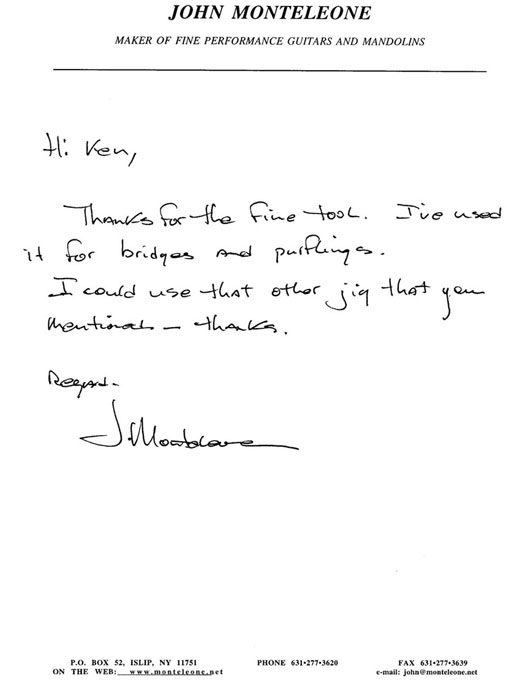
--------------------------------------------------------------------------------------------------------------------
Bruno Stefanini is a maker of fine italian violins. His workshop is in Bologna.
Ken,
I finally got on working with the Robo sander, it works great !
It is really precise, fast and SAFE !! one thing I don't like about power tools you can get very badly hurt, your tool is safe, I love it.
I also used it upside down, I mean I took it apart and I reversed it, I put the weel up with the drum sander down, this allowed me to duplicate a violin board.
The problem is finished boards are arched so there is no way to use it the way the sander it is put together, so I simply glued the board on top of plywood and sanded it to duplicate and get a template, then I used the template to copy the outline, fast, smooth, and most of all precise.
Grat job, worth each penny (Euros.....)
take care
Bruno
Bruno Stefanini Liutaio
via delle Belle Arti 9/b
40126 Bologna, ITALY
--------------------------------------------------------------------------------------------------------------------------
Steve Marchione is classically trained maker or fine archtop & electric guitars:
I've been using your tool exclusively for thicknessing ivory.
It's the best. I never waste a single piece!
--------------------------------------------------------------------------------------------------------------------------
Larry Stamm a Canadian Luthier purchased his Luthier's Friend at the GAL Convention in Tacoma .
"I've put the Luthier's Friend to good use, and have been meaning to get back to you about it. So far, I've used it for thicknessing headplate veneers, binding , and purfling strips, bridge blanks. and bone nut and saddle blanks. I've also been able to thickness a lot of little scraps for friends that do intarsia and marquetry that otherwise would get thrown out . It's a great tool that can be set up in very little time and makes it easy to thickness all those little pieces that were really difficult to put through a thickness planer . or hold down for hand planing,before. I'd say it has paid for itself already."...Larry Stamm
------------------------------------------------------------------------------------------------------------------------
Ketih Davis is an exceptional violin maker/repairman and is one of my most enthusiastic and innovative users.
Ken, if I wear this Luthiers Friend out, I'll want another one. Here are three more ideas:
1. Last week I had to make a new bass-bar for a viola. Usually planed both sides.....this time I planed one side to make it run perfectly with the run of the grain, then faced it to the wanted thickness in the LF....fast and accurate
2. Needed a bone saddle in a Mandolin bridge, so it chucked the downcut slotting bit in the drill press , ran the slot and then made the remainder of the cuts
on the LF and by hand.
3. In making a new lap dulcimer I needed the "dropped" portion of the fretboard flat, accurate and smooth.......rough sawed it on the bandsaw, then slilpped it into the LF from the top and made a couple of passes against the drum, backed by the adjustable table. Fast, smooth........better than the old way.
How can a shop run without one of these? Keith
